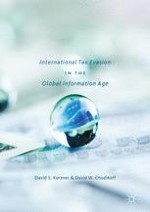2016 | OriginalPaper | Chapter
7. Article 26 of the OECD Model Tax Convention on Income and on Capital
Authors : David S. Kerzner, David W. Chodikoff
Published in: International Tax Evasion in the Global Information Age
Publisher: Springer International Publishing
Activate our intelligent search to find suitable subject content or patents.
Select sections of text to find matching patents with Artificial Intelligence. powered by
Select sections of text to find additional relevant content using AI-assisted search. powered by
